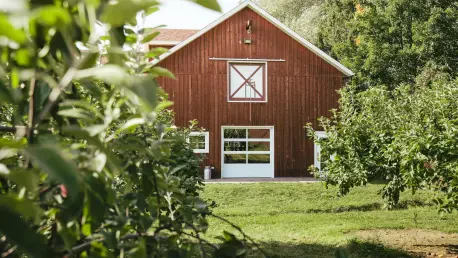Canadian agricultural insurance currently grapples with a multifaceted crisis marked by capacity constraints, escalating costs, and evolving farm landscapes. These challenges render the traditional insurance model increasingly inadequate, prompting an urgent need for systemic reform and innovative solutions. Restrictions on insurance availability not only pose financial burdens but also reflect broader industry shifts driven by regulatory changes, technological advances, and economic pressures. As the balance between supply and demand for farm insurance skews, the sector finds itself at a critical crossroads, prompting stakeholders to reassess risk management practices amidst transformative industry dynamics.
Navigating Capacity Constraints
Limited Reinsurance and Growing Loss Ratios
A significant shift is occurring within the insurance sector, characterized by a diminishing number of carriers capable of supporting the expanding insurance demands of modern agriculture. This challenge is exacerbated by increasing operational costs and a surge in the severity and frequency of loss events. Insurers face adverse loss ratios that over time may threaten their financial viability. This predicament has initiated a wave of strategic reassessments among insurance providers, prompting some to reduce their exposure to high-risk areas. For instance, coverage for confined livestock operations has become scarce as insurers withdraw in response to prohibitive risk factors and the associated loss potential.
Coupled with these trends is the constrained capacity within reinsurance markets, a critical safety net for many primary insurers. As reinsurance capacity becomes scant, the ability of insurers to responsibly underwrite new business is curtailed, creating a bottleneck in the market. This situation is particularly acute in regions where agricultural expansion places additional pressures on infrastructure and resources, escalating demands on the insurance framework tasked with serving them. Innovative strategies and advanced technological integration are becoming essential as insurers look for alternative means to manage exposure and ensure the sustainability of coverage for Canadian farms.
Restructuring within the Farming Sector
The challenges associated with shrinking insurance capacity are compounded by significant restructuring within the Canadian agricultural sector itself. The latest census data indicates a decisive move toward larger-scale farming operations characterized by substantial investments in infrastructure. These consolidation trends result in fewer but considerably larger farms with significant assets, leading to increased demands for more comprehensive insurance coverage. However, the insurance industry’s current capacity is not expanding commensurately with these needs, leading to a widening gap between the risk exposure of modern farms and existing coverage resources.
This disconnect between burgeoning operational size and static insurance capacity presents risks not just to farmers but also to insurance providers. Larger farms necessitate extensive risk management protocols and more nuanced coverage solutions that often transcend traditional insurance product offerings. The industry’s ability to bridge this divide will likely hinge on embracing new models, adopting regulatory compliance strategies, and integrating state-of-the-art technology to aid in risk assessment and mitigation. These adaptations will potentially catalyze an evolution of the insurance landscape, necessitating flexible solutions that address the consolidated scale and complex risk profile presented by today’s agriculture.
Economic and Regulatory Pressures
Impact of Regulatory Changes
Regulatory developments are becoming increasingly pivotal in shaping the economic landscape of Canadian farm insurance. A significant regulatory shift is the introduction of a national farm building code, designed to enhance resilience and operational safety amidst growing climate change concerns. While the code aims to secure operations against environmental risks, compliance costs have risen sharply, influencing overall budget allocations within farming communities. The increased expenditure, which affects everything from new constructions to the refurbishment of existing facilities, compounds the financial burdens faced by farmers.
Moreover, tariffs on key construction materials, including steel and aluminum, continue to inflate costs, further complicating budgetary planning for farming operations. These materials are essential for infrastructure development and repair, and cost hikes directly impact the economic calculus of risk transfer. As construction and operational requirements grow more financially demanding, insurers face heightened pressure to adjust premiums, challenging the feasibility of maintaining affordable insurance solutions. This economic tension underscores a larger need for adaptive strategies capable of meeting rising regulatory demands while ensuring accessibility to necessary coverage.
Supply Management System Uncertainties
Ongoing discussions surrounding potential modifications to Canada’s supply management system introduce another layer of complexity and uncertainty for the farm insurance sector. These regulatory dialogues, particularly within the dairy industry, hold significant implications for trade policies and operational sustainability. Should negotiations lead to deregulatory outcomes, many farmers might be compelled to scale up production facilities, impacting everything from infrastructure to resource allocation.
Expanded farming operations would naturally lead to increased insurance demands as operations require larger and more sophisticated coverage options. This shift underscores the necessity for insurers to develop scalable models capable of accommodating more extensive asset portfolios. However, as large-scale operations grow, existing capacity strains within the insurance industry only become more acute. This dynamic situation necessitates constant vigilance and proactive policy adjustments to ensure that emerging demands do not overwhelm the current infrastructure, thereby threatening the socio-economic balance within rural farming communities.
Leveraging Technology in Risk Management
Technological Innovations Enhancing Risk Detection
With the growing complexity of modern agricultural operations, technology has emerged as a critical component in bridging the gap between capacity and demand in farm insurance. As farms expand, often incorporating sophisticated machinery and infrastructure, the ability to promptly identify and address potential risks diminishes. In response, insurers are turning to technological innovations to bolster risk management efforts and enhance operational visibility. Technologies like PrevTech Innovations’ electrical monitoring systems represent a pivotal step forward, offering real-time fault detection to prevent catastrophic outcomes. By identifying issues before they escalate into substantial claims, these tools significantly reduce both financial liabilities and operational disruptions.
Insurers are also employing thermographic imaging to scrutinize electrical frameworks, selecting areas with significant risk potential for interventions such as fireball-mounted automatic extinguishing units. These advancements in fire suppression not only provide immediate risk assessments but also proactively reduce potential hazards. Moreover, insurers are investing in the development of AI-powered self-inspection tools, achievable through smartphone camera capabilities—an advancement enabling farmers to identify deteriorating plumbing fixtures and electrical issues promptly. This technological emphasis represents a major shift from traditional surveillance methods, aligning with the evolution of farm operations that demand comprehensive, real-time risk management solutions to ensure continuity and mitigate losses.
Insurer-Led Prevention and Risk Assessment
The evolving landscape of agricultural insurance places significant emphasis on prevention and proactive risk assessment. Unlike industrial sectors where safety officers are pervasive, farm operations typically lack dedicated personnel for consistent risk reviews. Consequently, the onus falls increasingly on insurance providers to foster prevention methodologies and carry out systematic evaluations. Companies like Nova Mutual are pioneering this approach by conducting extensive safety inspections and fire prevention surveys within agricultural settings. These practices illustrate the broader industry potential to standardize such assessments as a core component of insurance offerings, enhancing sector resilience.
Insurance carriers aligning with organizations like the Canadian Farm Builders Association (CFBA) benefit from the collective focus on implementing rigorous safety standards. As regulatory frameworks like the National Farm Building Code take effect, educational initiatives led by associations such as CFBA aim to guide compliance with contemporary safety norms. These efforts foster a culture of preventative stewardship and shared knowledge that aligns with long-term operational viability and risk reduction across farming communities. Engaging collaboratively in structured risk mitigation showcases a holistic approach for insurers to transform the industry, leveraging prevention as a sustainable synergy between safety and economic pragmatism.
The Path Forward
Bridging the Gap in Insurance Models
The current landscape of Canadian farm insurance underscores the pressing need for novel strategies to tackle the intertwined challenges of capacity limits, cost pressures, and regulatory requirements. As traditional insurance models face increasing scrutiny, the demand for innovative solutions that address the unique intricacies of modern agriculture grows more urgent. Insurers are encouraged to explore diverse mechanisms, from advanced reinsurance strategies to the structuring of more comprehensive policy frameworks, to meet the demands of contemporary farming operations.
Implementing shared risk models and expanding facultative reinsurance are among the potential pathways for redefining traditional practices. By distributing exposure, these strategies create more resilience within the insurance market. However, the scale and complexity of current farm operations require that these approaches be both flexible and scalable to remain effective. Enhancing collaboration across industry stakeholders, including technological innovators and policymakers, offers transformative potential for future-proofing. This convergence towards integrated solutions enables alignment with farmer needs and bolsters the sustainability of insurance models moving forward.
Collaborative Innovation and Sustainable Practices
Agricultural insurance in Canada is currently facing a significant and complex crisis, characterized by limited capacity, rising costs, and shifting farming landscapes. These issues are making the existing insurance model outdated and insufficient, underscoring the urgent necessity for comprehensive reform and creative solutions. Reduced accessibility to insurance does more than strain finances—it mirrors broader transformations within the industry fueled by regulatory changes, technological progress, and economic stressors. As the equilibrium between the demand and supply for farm insurance tilts, the sector stands at a pivotal junction. This situation compels stakeholders to re-evaluate their approach to risk management as they confront the evolving dynamics of the agricultural industry. Addressing these challenges requires innovative strategies to enhance resilience, adaptability, and sustainability in risk management practices for Canada’s agricultural future.









